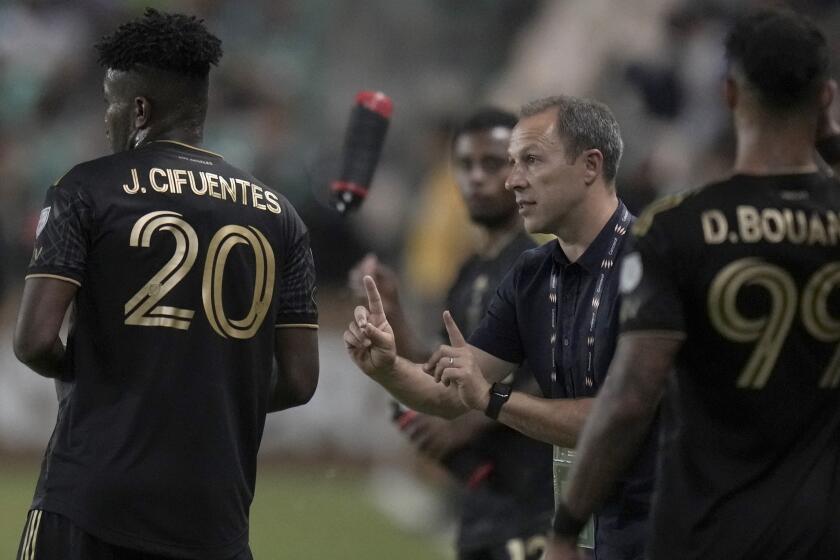Grand Prix of Endurance : ‘Slowpokes’ Worry Prototype Drivers
- Share via
RIVERSIDE — Southern California has long been known for its traffic problems. So, perhaps it’s not surprising that a traffic problem would carry over to the race track.
It certainly has been the top subject of many of the leading drivers who have been preparing for today’s eighth annual Los Angeles Times/Ford Grand Prix of Endurance at Riverside Raceway.
As would be expected, most of the complaints have come from the drivers of the 200-plus m.p.h. prototype machines. They are concerned about the dangers of trying to get around Riverside International Raceway’s 3.25-mile circuit while dodging cars capable of going only 140 m.p.h.
Veteran English driver Derek Bell is one of the most vocal of the prototype protesters. He and teammate Al Holbert, driving a Porsche 962, will be favored today in the six-hour race.
“It is bloody dangerous when you come upon a car that is going almost 100 m.p.h. slower,” Bell said, “especially when you are not always sure the driver of the slow car even sees you coming. Not only is there the difference in speed. There is also the difference in ability of the drivers.
“I am often asked what I consider the most dangerous race, and I always answer the 24 Hours of Le Mans because of the traffic problems. And there, they now limit the field to 50 cars on a track that is seven miles to the lap, so it doesn’t make much sense to me to start the same number here on a track that is just over three miles in length.”
Originally, all 72 entries were going to be allowed to start today. But the sanctioning International Motor Sports Assn., in a response to the many complaints, decided to limit the starting field to the fastest 50 qualifiers.
“It is a help, but it still is going to be awful,” said Elliott Forbes-Robinson, who will share the wheel of the Nissan GTP turbo with Geoff Brabham. “Take the esses (a series of three turns), for example. We are going to be going through there at 165 m.p.h., and if you come upon a car capable of a top speed of only 140, you can really have a problem. Say the driver of the slower car checked his mirrors going into Turn 2 and saw nothing, but by the time he gets to the start of the esses at Turn 4, there you are right behind him.
“Even if you have room to pass, he might turn into you in his surprise, or he could go off the road. In either case, you have a problem you don’t want.”
Another critical area, according to Forbes-Robinson, is the kink at the end of the long back straight that leads to Turn 9, a high-speed right-hander.
“That is the fastest part of the track, and you have to set up for it a long way ahead,” he said. “If a slower car changes direction there, it can be a real thrill when you have to adjust at those speeds.
“It would be bad enough to have to do it once, but when you figure that we are lapping the course almost 20 seconds faster than the slow cars, that means that every three or four laps you have to pass the same guy again. Over six hours, it becomes a very dangerous situation.”
Not all the drivers of faster cars agree. One who doesn’t is John Paul Jr., who broke his own lap record Friday in winning the pole position in his Buick-powered Hawk.
“Racing is passing cars, and it one of things I like most,” Paul said. “It is one of the more enjoyable parts of racing to be able to set yourself up to pass both fast and slow cars. I’m all for having them in the race.”
Another driver in disagreement is Michael Chandler. He will be in a Ford Thunderbird in the GTO class in his first competitive drive since suffering severe injuries in 1984 in a practice crash at Indianapolis.
“I’ve been away a while and I need to get used to driving in traffic again,” he said. “Nothing will sharpen your reflexes any better than having to watch out for slower cars ahead and, at the same time, keeping watch in your mirrors for the fast cars.”
The traffic problems are not limited to the prototype drivers.
Jack Baldwin, the fastest qualifier in the GTO division in a Chevy Camaro, said that problems with slow cars cost him a chance at a lap record for the class.
“We were fastest yesterday (Friday) and were pretty sure our time would hold up in today’s qualifying, but we wanted to get the record for Chevrolet and the team,” he said. “We got close, but I could never get in a clean lap during the whole session.
“The good drivers are not a problem. It is always the same ones that make this job hard and sometimes very dangerous.”
Even Bob Earl, the fastest of supposedly the slowest class--the GTU cars--said he was bothered by slower cars.
“I’ve been held up by drivers of all classes of cars,” he said, “and it is a double problem for me because most of them have more horsepower than I do even if they are not lapping the track as fast. If I get behind a slow guy, say at Turn 2, I have no choice but to stay behind him all the way to Turn 6.”
More to Read
Go beyond the scoreboard
Get the latest on L.A.'s teams in the daily Sports Report newsletter.
You may occasionally receive promotional content from the Los Angeles Times.










